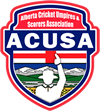General
- Drink intervals. Umpires should not remove the bails at drinks intervals.
- Left- and right-handed batsmen. Umpires need not cross over for left- and right-handed batsmen; it is a matter for individual judgement whether there is any advantage in so doing.
- Smoking – Umpires must not smoke on the field of play at any time.
- Umpires must be present for the toss 30 minutes before the scheduled starting time. This means moving out to the pitch five minutes earlier to give the captains time to get there on time.
Communication
- It is recommended that umpires signal to each other after the 4th fair ball of the over. Umpires must make sure that the 4th-ball signal is quite distinct from the no-ball signal.
- Wide. Umpires must turn to face the scorers to make the wide-ball signal.
- Bowling Change. Umpires should signal a bowling change to the scorers. (Pointing to the bowler is recommended.)
- LBW or Caught? If there is likely to be any doubt on the part of the scorers, the umpire should signal to the scorers. (Suggestion: cupped hands for caught; tapped ‘pad’ for lbw.)
- Wides and No balls. Law 3.14 [see also Smith p72ff] requires an initial call and signal, followed by a signal to the scorers when the ball is dead. Holding the initial signal for a second or two can alert the scorers to the fact that an ‘official’ signal will be coming. It is not acceptable to make only one signal.
- Pre-signal. Umpires should give a ‘pre-signal’ when runs are going to be signalled as byes or leg-byes. (Usually this is a hand extended slightly and below waist height [Smith p71]). It is a good idea to tell the scorers that you intend to use a ‘pre-signal’.
- Resumptions. At any resumption in play (including drinks intervals), the umpires must do all the checks required at the start of an innings. These checks include signalling to the scorers to ensure that they are ready.
- Height of the ball. Striker’s-end umpire should give a positive indication of height when the ball is over waist height or shoulder height, preferably by placing a hand at the appropriate level and raising it slightly.
- Striker’s Position. Striker’s-end umpire should hold her/his hands apart to indicate the distance from the striker’s back foot to the popping crease.
- Team Sheets. Umpires must ensure that team sheets are correctly filled in and signed. Ages of under-age players must be carefully checked so that restrictions on young players can be managed. Extra vigilance is required in Junior cricket. It is best practice to ensure that each player is given two names or at a minimum an initial and surname.
- Leg-side (One-Day) Wides. Any ball that passes down the leg side of the batsman should be called a wide – it is a good idea to explain this at the pre-toss meeting.
- Beamers. Umpires absolutely must issue the mandatory warning for all beamers, regardless of whether they are likely to be dangerous. Failure to do so is unacceptable.
- Front-Foot No Balls. Law 24.5 requires umpires to be certain that the delivery is legal. In case of doubt, call ‘No ball’.
Scorers
- Intervals. Generally scorers should approach umpires at the tea interval (between innings) to advise them of the score. (Umpires will not usually go straight up to the scorers at the close of an innings when they are very busy doing their final checks.)
- Junior Cricket. The quality of scorers at Junior levels is very variable. Umpires should be patient but persistent in getting acknowledgements of signals.
- Umpires are encouraged to use a ‘pre-signal’ so that scorers may be alerted to the fact that a signal will follow when the ball is dead. It is a good idea to ask umpires what their ‘pre-signal’ is.
- Acknowledgements. The scorers’ practice of repeating the signal back to the umpires is recommended. (Umpires should wait until they have received an acknowledgement for the first signal before making a second signal.)
